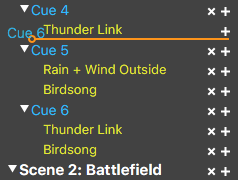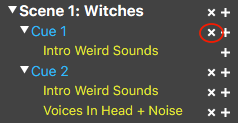Cues (MacOS)
Cues are the basic building block of the Show. They contain all the audio that will play until the next Cue is activated - or "cued". Transition types and fades are dictated by the individual Loops, since you may want these to be different for different sounds.
Cues can be triggered manually using the Cue button or they can be cued automatically by setting the Loop to a PLAY type.
Adding Cues
Your show will always contain at least one Cue, which will contain at least one audio Loop.

To add a Cue simply click on the '+' to the right of a Cue name in the Navigator. This adds a new Cue to the same Scene. If you need a Cue in a new Scene Add a Scene instead.

TIP: You can also append a Cue to the last Scene by double-clicking anywhere to the right of the last Cue.
If you want a new Cue at the start of a Scene, create one after the first Cue and then move it to the start. See Moving Cues.
Moving Cues
Use the Navigator to reorder/reassign your Cues. Click and hold the name of the Cue and drag it to the new position or different Cue. If the Cue you are moving is the only one in the Scene a replacement Cue containing a silent Loop will be inserted in its place, so the Scene is not empty. The old Scene can be deleted if it is no longer needed.

Renaming Cues
To rename a Cue click on its name at the top of the Cue Window. This will activate an editing field. Type in the new name and hit 'Return/Enter' to commit the change.

Deleting Cues
To remove a Cue simply click on the 'x' next to its name in the Navigator, or click the 'x' to the left of its name in the Cue Window.

Cuing Cues
While you are building the show you can move things around and preview individual Loops, but eventually you will want to run the Show and test the transitions between Cues. The basic principal is that starting with the first Cue, each Cue will play until it is manually cued, or it auto-cues itself.
To begin the Show and to cue between Cues simply click the green Cue button at the bottom of the screen or Cue in the Toolbar.


TIP: There are also keyboard shortcuts for the two main cuing actions.
Cue - Spacebar or Right-arrow
Back - Left-arrow
Cue Conflicts
TheatreSound doesn't prevent you from mixing different Loop types in a single Cue. For instance you might combine different auto-cuing PLAY types, and/or a LOOP-to-end types.
When it comes to Cues with conflicting triggers it will activate the next Cue at the earliest legitimate time.
Cue Reversal
Normally you just let the show progress by cuing manually or automatically. If, however, you trigger a Cue, and then want to go back to the previous Cue just press the Back button or toolbar.


Cue Selection
The show will start at the first Cue unless another Cue is selected. You can select a Cue by clicking on its name, or the names of any of its Loops in the Navigator, or by click on the Loop Window of one of its Loops. The show will scroll to the selected Cue.
TIP: This can be useful when entering Cue Notes. See Notes.
